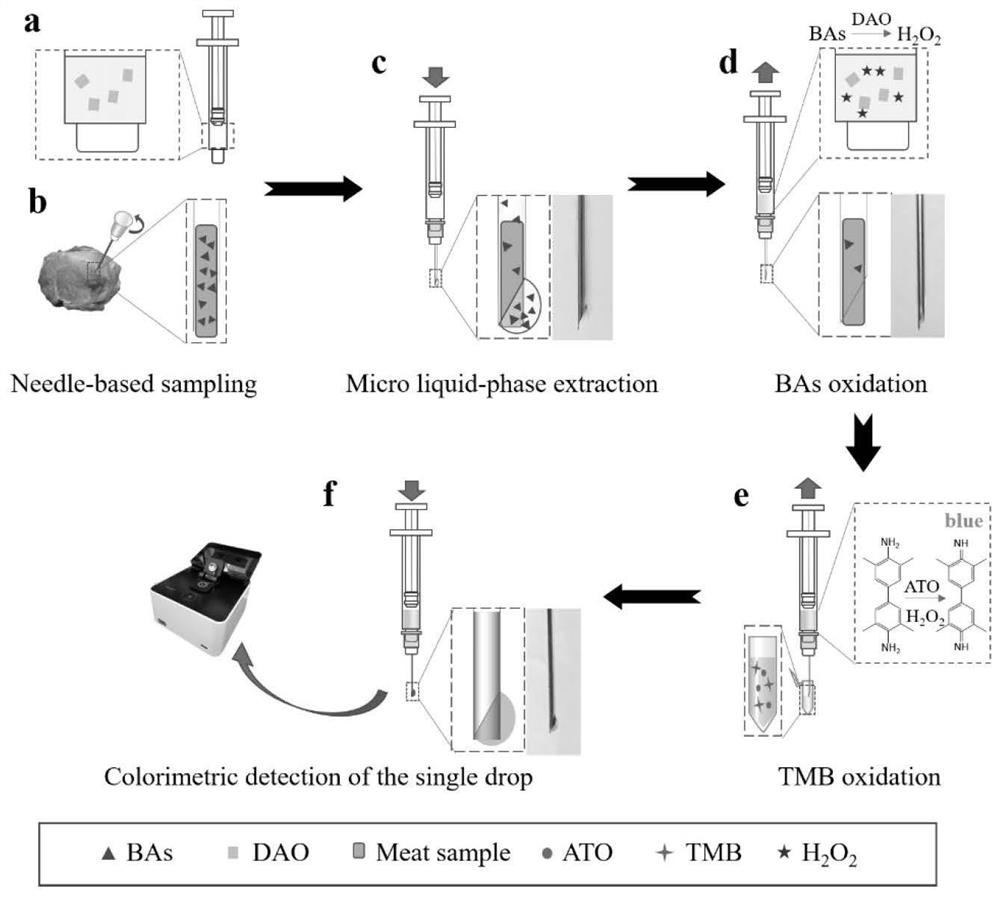Method for detecting biogenic amine through needle sampling-microextraction-catalytic color development
A technology of biogenic amines and needles, which is applied in the field of food analysis, can solve the problems of sample waste and achieve the effects of low cost, high detection efficiency and simple operation
- Summary
- Abstract
- Description
- Claims
- Application Information
AI Technical Summary
Problems solved by technology
Method used
Image
Examples
Embodiment 1
[0049] Specific detection method:
[0050] (1) First add 100 μL DAO solution to the centrifuge tube, then add 5 μL BAs solution, incubate in a water bath at 37°C for 20-35 minutes, add 45 μL mixed chromogenic solution after cooling, react for 10-25 minutes, and pipette 2 μL , followed by detection at 650nm with an ultra-micro UV-Vis spectrophotometer, and drawing a standard curve related to BAs and UV intensity;
[0051] (2) Use a syringe pump to absorb 100 μL of DAO solution, insert the needle into the meat sample, rotate clockwise and counterclockwise once, press the inclined surface of the needle on the meat sample to take it out, assemble the syringe pump with the needle, and push the syringe pump piston, Add a drop of DAO solution, soak the meat sample in it and react for 25-40min;
[0052] (3) Pull the plunger of the syringe to withdraw the BAs-extracted droplet, take out the meat sample with a clean needle, draw 45 μL of the mixed chromogenic solution with the syringe,...
Embodiment 2
[0059] Detection of BAs in fish samples:
[0060] In order to compare with the conventional method (i.e. HPLC-UV), the BAs content in the fish sample was measured by the method of Example 1, and the results were compared with the results from the HPLC-UV analysis; 20.51 The Bas of μ M; HPLC-UV measuring value is 20.01 μ M; In order to evaluate matrix effect, these samples have also carried out standard addition detection; As shown in Table 1, obtained good rate of recovery (96.76-97.76%); Above-mentioned result and The results of HPLC-UV detection were comparable.
[0061] Table 1 Comparison of detection results between HPLC-UV and this method
[0062]
[0063] a Relative recovery = (total concentration - blank concentration) / spiked concentration
Embodiment 3
[0065] Detection of changes in BAs of fish and pork under different storage conditions and different parts of fish over time:
[0066] (1) Divide the pork (purchased in the supermarket) into 6 portions, which are sealed at room temperature, exposed at room temperature, sealed at 4°C, exposed at 4°C, frozen at -20°C and frozen at -20°C. mouth packaging. Take the abdomen of a fish (purchased in a supermarket) and divide it into 4 parts, which are sealed at room temperature, exposed at room temperature, sealed at 4°C and refrigerated at 4°C; ) is divided into four parts: fish head, fish back, fish belly and fish tail, packed in separate bags, and stored in a refrigerator at 4°C;
[0067] (2), adopt embodiment 1 method, the situation that pork and fish meat BAs content changes with time under different storage conditions is detected; Figure 4 As shown in a, under the four storage states, the total amount of the three amines in the samples accumulated continuously over time, and...
PUM
 Login to View More
Login to View More Abstract
Description
Claims
Application Information
 Login to View More
Login to View More - R&D Engineer
- R&D Manager
- IP Professional
- Industry Leading Data Capabilities
- Powerful AI technology
- Patent DNA Extraction
Browse by: Latest US Patents, China's latest patents, Technical Efficacy Thesaurus, Application Domain, Technology Topic, Popular Technical Reports.
© 2024 PatSnap. All rights reserved.Legal|Privacy policy|Modern Slavery Act Transparency Statement|Sitemap|About US| Contact US: help@patsnap.com










